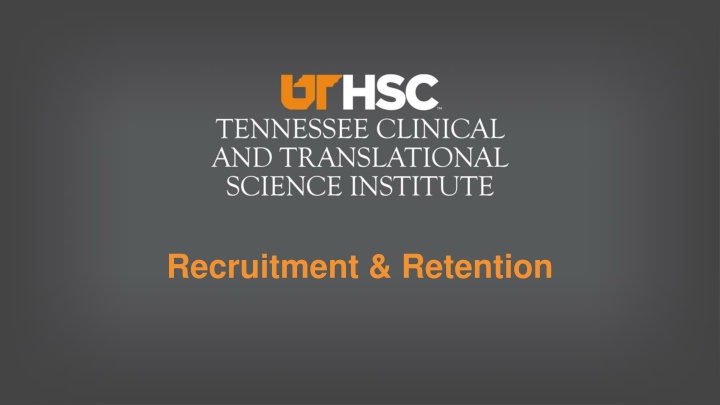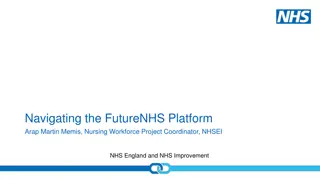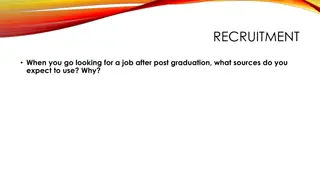Enhancing Recruitment and Retention Strategies in Research Settings
This content delves into the challenges and approaches in recruitment and retention processes for research studies. It covers topics such as review of recruitment tools, engagement in discussions on effective practices, utilization of mass mailings and social media for participant recruitment, and methods of direct recruitment. The discussion also emphasizes the importance of creating recruitment materials, developing feasibility studies, and employing strategies for participant retention. Various recruitment methods like referrals, recruitment letters, and IRB-approved protocols are highlighted, showcasing the need for innovative approaches to attract study participants, especially in a research institution setting.
Download Presentation

Please find below an Image/Link to download the presentation.
The content on the website is provided AS IS for your information and personal use only. It may not be sold, licensed, or shared on other websites without obtaining consent from the author.If you encounter any issues during the download, it is possible that the publisher has removed the file from their server.
You are allowed to download the files provided on this website for personal or commercial use, subject to the condition that they are used lawfully. All files are the property of their respective owners.
The content on the website is provided AS IS for your information and personal use only. It may not be sold, licensed, or shared on other websites without obtaining consent from the author.
E N D
Presentation Transcript
Objectives Objectives Review long-standing standard recruitment practices Discuss recruitment tools Engage in an open table discussion to share recruitment and retention practices that work
Recruitment and Retention steps Utilization of mass mailings, social media, and other outlets for participant recruitment. Feasibility studies using local and national databases Developing a recruitment plan Creating recruitment materials Strategies for retention
Recruitment Recruitment
Recruitment Recruitment Like many other research institutions across the country, there are recruitment challenges for our researchers and limited ways to search for willing volunteers to participate in our studies. At UTHSC, we have the Recruitment Innovation Center(RIC) as a resource. The RIC provides support and expertise recruiting study participants and enhancing retention by developing, implementing, and disseminating new, as well as, proven and effective tools including use of Electronic Health Records (EHR) for study planning feasibility analyses.
Methods of recruitment Methods of recruitment Direct recruitment of potential study participants. Examples of this strategy are physicians talking with clinic patients about the study, contact between the study team and potential subjects in person, via phone or on-line. With this method considerable care will have to be taken so that the person contacted does not feel pressured to participate. Recruitment letters. Ideally the recruitment letter would come from a person or an agency/clinic known to the prospective subject informing the prospective participant about the study. The letter would ask the person to call a number or visit a website for additional information if interested in participating in the study. Random or other probability sampling. This could include snowball sampling, random digit dialing, or other methods used primarily in the social and behavioral sciences. Referrals. Referrals may be from non-investigator healthcare providers or participants referring other participants. Investigators may provide their colleagues with a Dear Patient letter or a Dear Potential Study Participant letter describing the study. IRB-Approved Screening and/or Recruitment Protocol and/or Recruitment Database. Investigators can contact potential subjects, former research participants who have given permission for future contact, about particular studies in accordance with their protocol and the (typically signed) consent of the prospective subject. In many cases, prospective participants may have given permission to be contacted for future studies by means of check-off box in a consent form for a previous study.
Types of recruitment materials and sources Types of recruitment materials and sources Electronic Data Warehouse (EDW) ResearchMatch.org Recruitment letters Scripts for telephone or in-person discussion Flyers, posters, postcards, newspaper ads, press releases intended for recruitment with study team contact information MemphisPowerAds - advertisements included in MLG&W bill and also offered digitally TV and/or radio spots Websites/internet ads Electronic mailings (e.g., email, text) Social media pages, ads, blogs, tweets, etc. Please visit our website https://tnctsi.uthsc.edu or Blackboard page TN-CTSI on Blackboard for a comprehensive list of recruitment sources and contact info.
Recruitment tool feasibility analysis Recruitment tool feasibility analysis Advertising Medium Network/Broadcast TV Strengths Sight, sound, and motion Highest reach potential of all media types Immediate reach Audience selectivity in certain programs Aggregated data from Methodist LeBonheur Healthcare Minimal cost Efficiency More segmented audiences - easier targeting Lower out-of-pocket expenses Low production costs Builds audience quickly News environment Short lead times for space and material Good for merchandising and promotional support Potential for re-exposure through pass-along Lower cost Numerous advanced targeting options Good frequency builder Weaknesses Highest out-of-pocket costs Highest production costs Competition for the audience s attention Electronic Data Warehouse Limited to MLH Radio spots & Radio Show segments Non-intrusive/background medium A lot of competition for the audience s attention Portable medium, not suited for getting an immediate response More limited reach versus TV High out-of-pocket cost Relatively inefficient Cluttered environment Slow accumulation of audience and reach Circulations are in serious decline Short shelf life Slow build up of reach Some users tune out bulletin board ads A lot of competition for the audience s attention Newspapers & Local Magazines Commercial Appeal Memphis Flyer Digital UTHSC electronic bulletin boards Other university -bulletin boards Social Media Facebook Twitter ResearchMatch No cost Easy to edit and update Quickly builds audience through easy sharing Free study/participant matching tool National reach Simple study submission and navigation Not easily trackable except for sharing Limited audience if not passed along New tool at the onset of increasing public knowledge is slowly generating regional participants
Mass mailing Mass mailing directFX (https://directfxsolutions.com) is a local company that can provide addresses and mailing for recruitment. directFX has contracts with sources such as U.S. Data and Info U.S. Example: Requested list for study subjects needed : Males, 30-55 yo, African-American with a diagnosis of T2D in the greater Memphis area. Quantity Available: 4,161potential participants Cost of list - $395 Cost To produce 9.0 x 6.0 Digital printed postcard- 100lb Gloss Cover with 2 colors - $650 Cost To mail - $250 Total cost : $1295
The ResearchMatch website is a web-based tool that was established as a unique collaborative effort with participating sites in the NIH Clinical and Translational Science Awards Consortium and is hosted by Vanderbilt University. ResearchMatch (RM) is a registry allowing anyone residing in the United States to self-register as a potential research participant. The ResearchMatch system employs a matching model Volunteers self-register and Researchers search for Volunteers for their studies.
For Researchers: The ResearchMatch website is easy to navigate. Once registered as an approved researcher, you can run a feasibility study for our region to assist you with study development prior to submitting your study for recruitment. For Volunteers: It's convenient and easy to use and promotes volunteer choice; there is no obligation to participate in studies. The system is safe and secure. All volunteer information is kept confidential until the volunteer decides to release it.
Retention Retention
Retention planning Retention planning Loss of participants can occur at any point during a study for various reasons. However, attention to detail can significantly reduce those losses and result in higher subject satisfaction and more accurate study data. Formulating a retention plan is essential.
Identified issues in participant retention Identified issues in participant retention Numerous studies evaluating retention among research participants show that the following factors, with the exception of drug side effects, are most reported for subject dropout or withdrawal: Consent form was difficult to understand Questions about the consent form and/or study were not adequately answered Stressful site visits Participants did not feel adequately motivated to stay in study
Proven methods for increased retention Proven methods for increased retention Informed Consent Discussion: Clear information given Time allowed for participant to consider options and formulate questions Thorough answers provided in a timely manner Expectations explained and set Site/study visits: Easily understood instructions and directions Patient-friendly environment Relationships formed between staff and participant Motivation and continued support: Continual education Reminders for upcoming visits Check-ins for patient support Recognition and appreciation
The Retention Key The Retention Key The retention plan should have time-spent factored in to all aspects of participant involvement. Time-spent isn t simply a placeholder for Q&A or scheduling reminders for study visits, but the key to higher retention. Time spent should represent the dedicated visit or call with a participant that helps him or her understand his or her importance in the study. Participants need to know that their time is recognized and appreciated. Higher participant satisfaction, richer study data, and potentially better study outcomes result from quality time-spent.
TN TN- -CTSI resources and CTSI resources and contact information contact information
Resources and more can be found in the Resources and more can be found in the following locations: following locations: TN-CTSI website https://tnctsi.uthsc.edu/ TN-CTSI Blackboard page CTSI2019: TN-CTSI Educational Resources TN-CTSI office 66 N. Pauline Suite 232 901-448-CTSI (2874) tnctsi@uthsc.edu























